°Arcus°
Home » Creation stories » Western Oceania
CREATION STORIES FROM WESTERN OCEANIA
BANKS ISLANDS
The Banks Islands form a part of the state of Vanuatu. The Melanesian inhabitants tell of a creator, the sun god Quat.
At the beginning, there was everywhere, permeating the universe, light. This shone upon Quatgoro, the mother-stone, which eventually caused her to break open, releasing Quat and his eleven brothers. These kinsmen of the sun god were all named Tangaro and represented a particular facet of the cosmos.
The twelve grew up in very short order, whereupon Quat carved the earliest humans from different parts of a tree, forming them into six puppet-like figures. These he set in a line and danced in front of them, which gradually caused them to come alive. Beating his drum, the six began to dance. Eventually, Quat had made six men and six women from the puppets.
The Foolish Tangaro had seen Quat's work and decided to give it a try himself. He made six puppets and danced them into life, but buried them, forgetting about them for a period. When he remembered them, he returned and dug them out of the earth, he found them rotten and devoid of life. Henceforth, death was present in the world.
Quat, meanwhile, was continuing his work, making bipedal pigs, which caused the Tangaro brothers to mock him. Thus, Quat modified their body plan, making them walk on all fours. Other creations were plants, animals, rivers and useful things such as canoes.
One day, he set off in a canoe to the ends of the earth, where he found Oong (Night), a land devoid of all light. There, Quat learned about sleep, while he gained dark eyebrows and a portion of Oong to take back to this world.
On his return voyage, Quat sojourned a while in the Torres Islands, exchanging a portion of Oong for some birds. These began to follow Oong, and their chirruping enables humans to know that day is coming.
Back home, the Tangaro brothers awaited Quat's return. He taught them to make beds from coco leaves and to lie down. He then released other pieces of Oong, whereupon the sun began to sink and darkness came to envelop the earth. The brothers were alarmed at this turn of events and became terrified of the coming of sleep, believing they might be dying. Quat reassured them, before cutting a hole in Oong with a red stone, which gave rise to the red light of dawn.
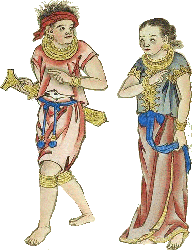
BISAYA
In the beginning, two gods dwelt alone in the sky. Their names were Kaptan and Maguayan. Kaptan fell in love with Maguayan, and the pair eventually married. All was not well, however: after an argument, Kaptan demanded that Maguayan go away, which she did, with no little sorrow.
Kaptan, however, was not happy. Regretting his fit of pique, he began feeling increasingly lonely, so, in order to keep himself occupied, he created the earth, in the midst of which was a garden containing a bamboo, kahilwayan. Seeing a breeze moving the leaves of the bamboo, Kaptan resolved to create creatures to tend his garden. Suddenly, the bamboo broke into two, with the first man and woman emerging from the slit of the node.
BUGIS
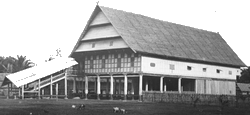
In the beginning, the world (South Sulawesi) was empty. Sang Patotoqe (La Patiganna), the ruler of heaven, held a council of various rulers including Senrijawa and Peretiwi and appointed his son La Togeq Langiq to become ruler of Alekawa, the earth, being given the name Batara Guru. Batara's mother was Datu Palingeq and his daughter by We Nyiliq Timoq was Sangiang Serri. He was succeeded by his son, La Tiuleng or Batara Lattuq.
Batara Lattuq had the twins Lawe (La Maqdukelleng) and Sawerigading (Putera Wareq) and a daughter, We Tenriyabeng. Sawerigading wished to marry We Tenriyabeng, unaware that she was his sister. Upon finding out, he departed from Luwuq, the land where the family ruled. He went towards China, defeating Setia Bonga, the ruler of Java. He eventually married We Cudai, a Chinese woman. He was the captain of a mighty ship which travelled the world.
Sawerigading's son was I La Galigo (or Datunna Kelling), who was also a great navigator and warrior. He married four wives. His son was La Tenrittatta, the last of the kings featured in the epic as having ruled in Luwuq.
CERAM
The mythology of the Ceramese people of the Molucca Islands in Indonesia focusses on the nine original families. These nine families emerged from bunches of bananas upon Mount Nunusaka, from whence they came down to the Nine Dance Grounds.
One of their number, Ameta by name, was much darker than his fellows and was something of a loner. One day, he set out hunting and managed to slay a pig, upon the tusk of which there was a coconut. Ameta took the nut home and wrapped it in a cloth, upon which was embroidered the figure of a snake. During that night, Ameta dreampt that a man came to him with instructions to bury the coconut, which Ameta did the following day.
Within days, there was a coconut tree in Ameta's garden. He climbed it to get some nuts but cut his finger. When he had tended to this, he made his way up again, but noticed that his blood had mingled with the sap to form a face. A few days later, he discovered a small girl there. That night, the man from Ameta's previous dream visited him again, telling him to wrap the child in the cloth and bring her to his home. Ameta obliged, calling the girl Hainuwele. Within days, she had grown and was in the habit of producing useful objects from her anus, which enabled Ameta to make a living through retail.
Some time later, the nine families were gathered at the Nine Dance Grounds. The women of the families took their place at the centre of the grounds, from where they gave the men betel nuts. Hainuwele did so on the first night, but thereafter gave coral on the second night and pottery on the third, followed by more and more ostentatious gifts on the fourth to eighth nights. This caused great envy among the ranks. Thus, on the ninth night, the people had hatched a plan to kill her. They dug a hole and pushed her in, before burying her.
Ameta then used his skills as an oracle to discover what had transpired. He went to the Nine Dance Grounds and planted nine pieces of a palm leaf in the ground, the ninth being at the very centre. He then struck them. After pulling up the ninth, he discovered material from Hainuwele's cadaver upon the stalk. Thereafter, Ameta dug up Hainuwele and cut her into pieces, burying all bar the arms in the Nine Dance Grounds. From where he interred his child, the various plants grew which are used as staples by the Ceramese.
The arms he took to the goddess Satane, who proceeded to the Nine Dance Grounds and built a gate, behind which she stood holding out the arms. She called the nine families and told them that, as a result of their murderous actions, she would leave them, after they had tried to get through the gate. Those who succeeded remained in human form, while those who did not became animals and phantoms. Satene then went to the Mountain of the Dead.
Another girl revered among the Ceram people is Rabia, who was spirited away by Tuwale, god of the sun, becoming the moon and instituting the Death Feast.
DAYAK
The Supreme Being fashioned sun and moon from sacred clay from deep within the earth.
Another story states that the universe existed within the maw of a giant snake, before Gold Mountain and Jewel Mountain emerged into the world. These were the home of the chief deities of the Lower and Upper Worlds respectively. These two mountains - and the worlds about them - crashed together, which led to the creation of the sky, rivers, sun, moon, stars and mountains, as well as cosmic beasts. These include Rowang Riwo of the golden saliva, Didis Mahendera, whose eyes were made of jewels, a heavenly hawk and a giant fish. Jata, a goddess, appeared later and continued the work of ordering the world, before the Tree of Life, which featured ivory fruit and golden leaves, came into being and brought the Upper and Lower Worlds together.
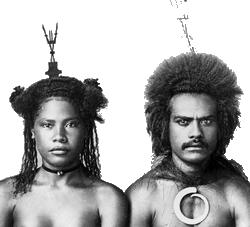
FIJI
In the beginning, the serpentine Ndengei created the universe. All was twilight and water around the island of the gods. This island floats around the edges of the earth and is occasionally visible at sunrise.
The Fiji archipelago was the work of Rokomautu, the son of Ndengei, who scooped them up from the bottom of the sea.
Ndengei, meanwhile, remains aloof from his creation, though earthquakes are ascribed to his rolling over. Additionally, day and night are associated with his waking and sleeping respectively.
IBAN (SEA-DAYAK)
The Iban (Sea-Dayaks) tell that, in the beginning, there was nothing but primordial waters, in which two spirit-birds - Ara and Irik - floated. Two large eggs appeared, from which Ara made the heavens and Irik the earth. The earth was then compressed, causing the mountains and valleys to form. Humans were then created from clay and brought to live through spirit-cries.
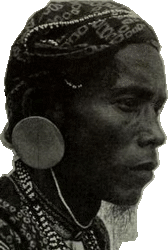
LUMAD (BAGÓBO)
In the beginning, Melu, a white figure with golden teeth, lived in the heavens. He was in the habit of polishing himself to preserve his whiteness, which led to exfoliated flakes of skin being deposited around him, from which he fashioned the earth.
Thereafter, he created two small people in his image. These people, however, had no noses. This led Melu's brother to offer to create these organs, though, as this demiurge was not the sharpest tool in the box, he put them on upside down, which caused the people to be in mortal peril of drowning when the first rains fell.
In order to stave off this threat, they took to standing on their heads beneath a tree. Melu saw them and asked what they were doing. Seeing their predicament, he turned their noses around, thus placing them in proper order.

MEE (EKARI)
Everything which exists was created by the desire of Ugatame, who makes his presence known to his people by the presence of the sun and moon.
Ugatame's nature is dual, both masculine and feminine, and Ugatame is the source of both good and evil, though exists beyond these concepts. All things are described as Ebijata and the Kapauku are believed to be related patrilineally to Ugatame. They are thus associated with certain plant and animal species which the particular kin group are forbidden to consume.
NEW BRITAIN
In the beginning, two culture heroes, To-Kabinana and To-Karuvu, emerged from the blood of a spirit. Later, two women emerged from coconuts and these became the mates of To-Kabinana and To-Karuvu. The result of these unions were the ancestors of the people. To-Kabinana and To-Karuvu then proceeded to teach the people how to survive in their environment. Unfortunately, To-Kabinana and To-Karuvu were not of the same mind: indeed, they were opposites, representing light and good; and darkness and evil.
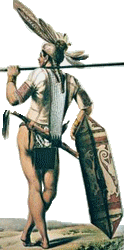
NGAJU
The Ngaju Dayaks say that the great god created the world from the sun and moon, giving it to people as a temporary home floating in the primeval waters. The primordial snake is identified with the Tree of Life, and it is set in these waters as the protector and supporter of the earth.
ORANG ASLI
The so-called Orang Asli of Malaysia are the earliest inhabitants of the region, and are related to other peoples termed "Negritoes," such as the Aeta of the Philippines and the populations of the Andaman and Sentinel Islands of the Bay of Bengal.
In the beginning, the divine couple Pedn and Manoid existed in a universe which featured a sun, but no earth. Some time later, the earth was formed from mud by the dung beetle. Thereafter, Pedn and Manoid descended to the newly-made planetary surface and produced children after Manoid begged Pedn for a child in a dream. Pedn had gone out and picked fruit from a tree, from which a male child was formed upon the fruit being placed upon a cloth. Next, Manoid dreampt that Pedn fashioned a girl child on the cloth from a seed of the tree. The children were the Kakuh-bird and Tortoise respectively. Eventually, Kakuh-bird and Tortoise married and produced offspring, one of whom fired an arrow into a rock, from which a spring began to gush forth.
PAPUA NEW GUINEA
The people of Papua New Guinea are extremely diverse: the country is the most linguistically diverse nation on earth.
Humans came out of a palm tree, after Gainiji heard them speaking their languages inside. After they emerged, the people went to each of their lands, which they still dwell in to this day.
According to the Kiwai, the creator was called Marungere. He gave the people the pig and taught them certain ceremonies.
SAN CRISTOBAL
In the beginning, there was Agunua, the creator snake and figona, with all other figonas being incarnations of him. He possessed wings and the head of a man, only with four eyes. He also had breasts, which suckled his creations. Agunua made the earth and the oceans from nothing, before proceeding to create humanity. To his brother, he gave a yam, telling him to plant it. From this came all of the foodstuffs used by the islanders. However, some foods are poisonous: these came from the brother's burning up a number of yams.
TAGALOG
In the beginning, the world was composed of water and sky, between which flew a glede. Weary from its constant motion, the glede caused the breaking of the equilibrium between water and sky, which prompted the sky to weigh down the water with islands to maintain its own position atop the cosmos. These enabled the glede to settle and restore the previous peace.
Eventually, the glede, standing on the shore, discovered a bamboo cane which had been floating hither and thither in the water. Opening it with its beak, the glede was surprised to see the first man and woman emerge from either joint. The pair married with the consent of Bathala Meycapal, the paramount deity of the Tagalog people.
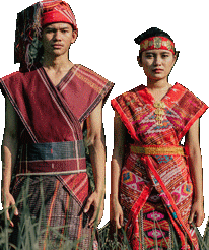
TOBA BATAK
The first god was Mula Jadi na Bolon, who emerged from nothing in the form of a tripartite division between upper, middle and lower worlds. This trinity was represented by the form of a world tree, linking the three parts of the universe.
Within this tree, there lived a bird, which lay eggs, from which emerged a second trinity, whose task was to govern the three worlds. The names of these three entities were: -
- Batara Guru, ruler of the upper world;
- Soripada, ruler of the middle world; and
- Mangalabulan, ruler of the lower world.
Batara Guru had a daughter, Sorbayati, who was engaged to Mangalabulan's son Raja Odap-Odap. Odap-Odap, however, had fallen in love with Si Boru Deak Parujar, Sorbayati's younger sister. This led Sorbayati to despair, and she threw herself from the roof of her father's house. Her corpse became bamboo and rattan.
Si Boru Deak Parujar, however, had no love for the reptilian Odap-Odap, and decided to escape his attentions by fleeing to the primordial ocean of the middle world, where she proceeded to fashion dry land from soil sent down by her father via a bird on the back of Naga Podoha or Padoha, the serpentine form who holds up the earth. Podoha was defeated by a hero sent by Batara.
Eventually, Odap-Odap assumed human form, whereupon Si Boru Deak Parujar agreed to become his wife. They produced twins, Si Raja Ihat Manisia and Si Boru Ihat Manisia, the first humans, followed by many other people, including the Batak's ancestor Si Raja Batak.
VANUATU
In the beginning, Naareau the Elder existed within the void of the primordial cosmos. After some time, he determined to create another, Nei Teakea, from his thought. Next, he formed a man, Na Atibu ("the Rock"). Otherwise, there were two brothers. One was wise, the other foolhardy. The wise brother created the cosmos, though, in order to keep disaster at bay, the foolish brother had to be sent into exile.
Eventually, Na Atibu and Nei Teakea mated and the fruit of their union was Naareau the Younger. Naareau the Elder then created the sky and earth closely-compacted within the darkness, before leaving the scene. Naareau the Younger, seeing the proximity of the sky and earth, made use of a magic song to create space between them, which resulted in a bat emerging from the gap. The bat was tasked with diving back into the hollow in order to glean information for Naareau the Younger as to conditions in the coid. The bat returned with news of a sleeping people he had found there. Naareau then sent him back to name the people.
Next, Naareau, with the guidance of the bat, entered the world of darkness. He ordered the people to move and helped them emerge from their inert state. However, they found that they were unable to stand due to the sky and earth still being too close together. One of their number, Naabawe, was sent to fetch Riiki, the conger eel. Unfortunately, Riiki bit Naabawe, so Naareau used another spell to conjure up the arms of an octopus to trap him. Riiki was then tasked with separating earth and sky.
Further acts of magical incantation were used by Naareau to lift up the sky from four directions, assisted by the octopus and turtle, to allow light into creation.
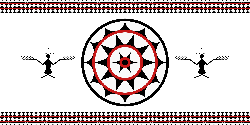
YAMI (TAO)
In the beginning, the Creator gazed down from above and saw Orchid Island. He liked it and dropped a stone onto a place where the village of Ipaptok would later be constructed.
As the stone landed, a man emerged and ate of a bean plant (paptok). He continued on his way and saw bamboo growing by the shore. This divided and another man emerged. The pair decided to part ways. Bamboo son found silver, while Stone son found iron.
Some time later, a boy burst from Bamboo son's right knee and a girl from his left. The same happened to Stone son. The children grew, married their counterparts and became ancestors of the people.
